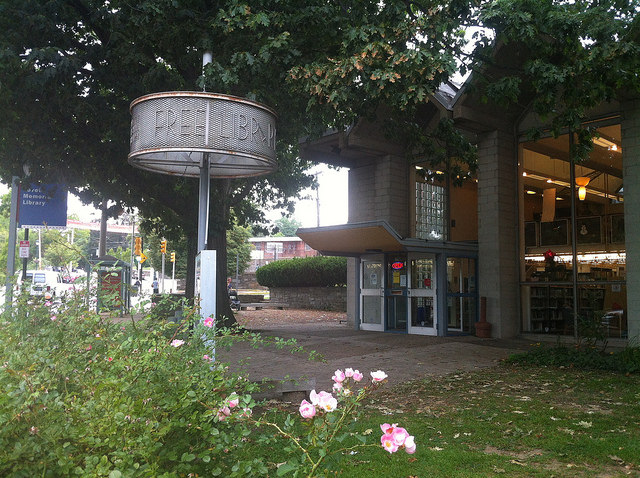
Five projects to transform civic spaces in Philly, yield lessons in collaboration
Cyclists on Bartram’s Mile. Photo: Philly Bike Coalition on Flickr.
Kathryn Ott Lovell is executive director of the Fairmount Park Conservancy in Philadelphia, one of 26 communities where Knight Foundation invests.
My family recently moved to West Philadelphia, a neighborhood that has undergone a dramatic transformation over the past 10 years—new residential housing, revitalized commercial corridor, an influx of millennials—but which has not lost its convivial spirit, spontaneous atmosphere and eclectic core. Related Link
“Building more successful cities the focus of new $11 million investment to reinvent Philadelphia’s public places” — Press release, 3/16/2015
Once you land in West Philly, it is almost impossible not to become mesmerized by Clark Park, a 9-acre swath of green space at the edge of the “University City” neighborhood and approximately 3 miles from Philadelphia’s downtown. At any given time, the people using Clark Park, spanning generations and ethnicities, might be engaged in a range of random activities that happen in the park on a daily basis: picnics, drum circles, slacklining, chess, flea markets, soccer, bocce, fire dancing, hula hooping, and “LARPing” (live-action role-playing) with homemade swords and shields.
Clark Park is a personification of its neighborhood’s core values; all are welcome, all are equal, here.
In many ways Clark Park continues the traditional history of urban parks in our country. In the late 19th century, urban parks were first conceived as “pleasure grounds,” offering city dwellers an escape from their rowhomes and industrial surroundings and access to natural open space. Parks were also equalizing spaces where people of various classes and backgrounds mingled and mixed.
Times, and parks, have changed over the past 100 years.
A recent report by renowned urbanist Richard Florida cites Philadelphia as one of the 10 most economically segregated cities in the United States. Florida says, “Where cities and neighborhoods once mixed different kinds of people together, they are now becoming more homogeneous and segregated by income, education, and occupation.” The concern is in how this segregation “threatens to undermine the essential role that cities have played as incubators of innovation, creativity, and economic progress.”
While this threat isn’t readily apparent in Clark Park, walk down the street in many neighborhoods in Philadelphia and you would no doubt experience this disparity firsthand.
At the same time, Philadelphia has been experiencing a renaissance in public space. In fact, The New York Times recently named Philadelphia as one of the top places to visit in 2015, most notably for our recent public space projects, including Dilworth Park and the Schuylkill Banks Boardwalk.
Emboldened by Knight Foundation and the William Penn Foundation, Philadelphia will spend the next few years “Reimagining Our Civic Commons”—and learning if parks, open space, libraries and recreation centers can reverse this trend towards economic and social segregation. Can urban parks once again become democratizing agents that create not just equity, but connection, to each other and to our natural habitat?
Through the “Reimagining Our Civic Commons” initiative, the Fairmount Park Conservancy—a nonprofit organization that exists to champion Philadelphia’s park system—will support five model projects, each in a transitioning neighborhood on the periphery of Center City:
Free Library of Philadelphia, Lovett Branch by Holly Tomren on Flickr.
· Bartram’s Mile: Reconnecting a historic botanical garden to Center City while reconnecting a neighborhood back to its riverfront.
· Discovery Center: Reanimating a 40-acre reservoir on the edge of the Strawberry Mansion community with an urban bird sanctuary and leadership development center.
· Reading Viaduct Rail Park: Transforming an abandoned railroad viaduct into a new elevated park in a changing multi-ethnic community.
· Centennial Commons: Reactivating an underutilized edge of a major public park to increase use by the adjacent neighborhoods poised for change.
· Lovett Library and Park: Reinventing a local branch library and adjoining open space into a civic center for a revitalizing community.
In addition to the capital investment in each of these model projects, the conservancy will also serve as lead convener of the “Civic Commons Collective,” an exciting new effort to bring together the model project partners for collaboration on research, programming and advocacy.
Too often, we are not just disconnected economically and socially in our civic lives, we are nonprofits and public space leaders disconnected from each other’s work. The question must be asked, are we stronger together? Through this collective, we hope to break down siloed efforts and collaboratively act as a laboratory of learning. Through this work, we will test the idea that a revitalized and connected set of civic assets can foster engagement, retain productive citizens and ensure the long-term prosperity of our city.
When my husband and I were looking for a new home we considered dozens of neighborhoods. We ended up in West Philly, and Clark Park absolutely played a role in that decision. The social and economic value of a neighborhood is intrinsically raised by the vitality of its public space. We want our family experience to include not just a connection to open space, but a connection to the community that surrounds it, and to the city at large.
Thanks to Knight and the William Penn Foundation, an extraordinary opportunity stands before us here in Philadelphia—to reimagine our civic spaces, reimagine our civic dialogue and reimagine our public partnerships. All are welcome, all are equal, here.
Recent Content
-
Communitiesarticle ·
-
Communitiesarticle ·
-
Communitiesarticle ·



